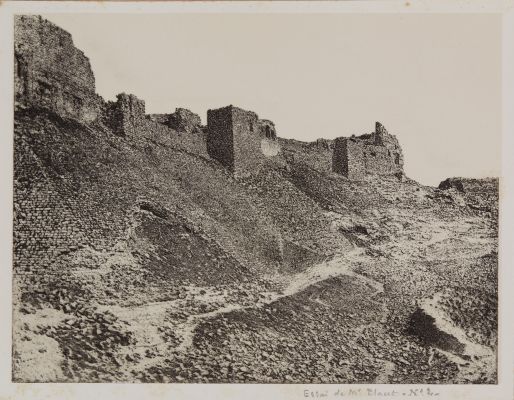
Title
Essai de Mr Placet – No. 1 –Artist
Sauvaire, Henri (French, 1831-1896)Publication
Test print for the Duc De LuynesDate
1866 plate (1865 negative)Process
Photogravure (Placet process)Atelier
Placet, EugeneImage Size
26 x 19 cm
This unique test made by Emile Placet from a photograph by Henri Sauvaire was likely a sample for the Duc de Luynes when he was considering alternates to Charles Négre to execute the photogravures for Voyage d’exploration: la Mer Morte. See https://photogravure.com/highlights/vinges-sauvaire-placet-negre-and-the-duke/ for an in depth account of this milestone in photomechanical history.
Emile Placet bought the contents of the Bisson Freres’s studio in 1864 and continued to print from their negatives. He also started to use their negatives and prints to experiment with a photomechanical process that he would ultimately refer to as "Heliographie Procédé Placet". It is possible that this print was produced by Placet at the request of the Duc de Luynes, who had previously established a reward for the invention of a permanent photographic process in ink (which Alphonse Poitevin won for his photolithography process). It was likely made between 1864 and 1866 since comparable prints by Placet in the Bibliotheque nationale bear a "depot legal" stamp date of 1866, though it is also possible that it could have been made slightly earlier. [1]
The de Luynes committee stated the following, M. Placet alone among competitors who have arrived since the prorogation of the competition, has successively presented to the Society engraved plates, which indicate sustained and persevering labor. His method is, at bottom, the molding indicated by M. Poitevin or M. Pretsch; but he has protected it by using a device of M. Fargier, which consists in washing and swelling the proof, not on the side on which the light has struck it, but, on the contrary, on the opposite side—the only means of obtaining delicacy in the half-tints, as has been mentioned by M. Laborde. By means of devices (or rather, we may say, of methods) which are peculiar to him, M. Placet obtains galvanoplastic plates which may serve for copper-plate, for letterpress, and, by transference, for lithographic printing. The specimens presented by M. Placet are sufficiently remarkable to entitle his name to a place among the important candidates. The transformation of photographic prints into panels suitable for intaglio printing is one of these important problems whose solution marks a new era in the history of photography. This problem is now resolved. M. Placet has only exhibited views of monuments which seem to form his specialty. But in this specialty, he succeeds in a complete manner, and the view of the interior of the cloister and the main portal of St. Trophime, at Arles, the portal of the church of St. Symphorien, at Tours, Tympanum of the portal of the Reims cathedral, representing the legend of Saint-Remy, – and many other tests, attest to it. This complete system, susceptible, according to its author, to numerous and interesting applications, earned M. Placet the first silver medal for gravure. [2]
Most of Placet process plates state “sans retouche” meaning that no hand work was done to the plate.
References
[1] According to Russell Lord
[2] Waterhouse, Catalogue of the Loan Exhibition of Process Engraving, 1905, pg. XII The Photographic Journal vol. 12 P. 74
Exposition universelle de Paris en 1867 : documents et rapports. v.1. P 447 link: https://catalog.hathitrust.org/Record/102139766
"Improvements in photo-engraving," The Photographic News, vol. 20, 1876, pgs. 196-197,
Gernsheim, Helmut. The Rise of Photography, 1850-1880: The Age of Collodion. London: Thames and Hudson, 1989. p.129
History of Photography Volume 14, Issue 3, 1990; Louis Vignes and Henry Sauvaire, photographers on the expeditions of the Duc de Luynes
